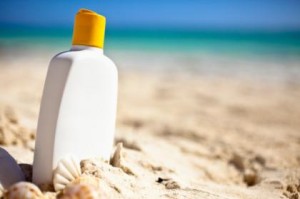What is SPF?
 There are many choices for sunblock: creams, mousses, sprays and powders, ranging from SPF of 15 to SPF of 55 or higher.
There are many choices for sunblock: creams, mousses, sprays and powders, ranging from SPF of 15 to SPF of 55 or higher.
Sunscreens are made with dozens of active ingredients that either use “absorbers” to create a chemical reaction to absorb UV rays or physical barriers that reflect and block UV rays. Many sunscreens incorporate both methods.
What is SPF?
Sunscreens are rated by the strength of their sun protection factor (SPF). The SPF number refers to the product’s ability to prevent UVB rays from damaging the skin.
A product with SPF 15, filters out approximately 93 percent of all incoming UVB rays.
A product with SPF 30, filters out approximately 97 percent of all incoming UVB rays.
A product with SPF 50, filters out approximately 98 percent of all incoming UVB rays.
- It should be noted that no sunscreen, regardless of strength, will stay effective longer than two hours without reapplication.
To ensure that you get the full SPF of a sunscreen, the average adult needs about 2 or 3 tablespoons of sunscreen to cover their body and 1 teaspoon to cover their face and neck. That’s about half of a 237ml bottle of sunscreen for a full day at the beach.
Sunscreens should be applied 30 minutes before sun exposure to allow the ingredients to bind to the skin. Reapplication of sunscreen is just as important, so reapply the same amount every two hours.
Sun tips:
- Sunscreen should be used on any exposed skin including ears, lips, feet etc
- Use a lip balm with SPF and reapply often
- Apply sunscreen on cloudy days – UV rays can pass through clouds
- Sunscreens have an expiry date; they contain chemicals that may not work as well after the expiry date
- Sunscreens can be affected by extreme changes in temperature, so leaving your bottle of sunscreen out in the sun all day, can destroy some of the chemical compounds and make the sunscreen much less effective.



Leave a Reply
Want to join the discussion?Feel free to contribute!